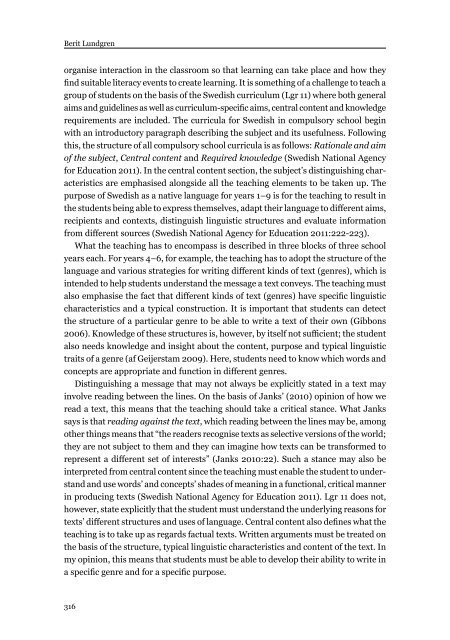Download issue - Umeå universitet
Download issue - Umeå universitet
Download issue - Umeå universitet
You also want an ePaper? Increase the reach of your titles
YUMPU automatically turns print PDFs into web optimized ePapers that Google loves.
Berit Lundgren<br />
organise interaction in the classroom so that learning can take place and how they<br />
find suitable literacy events to create learning. It is something of a challenge to teach a<br />
group of students on the basis of the Swedish curriculum (Lgr 11) where both general<br />
aims and guidelines as well as curriculum-specific aims, central content and knowledge<br />
requirements are included. The curricula for Swedish in compulsory school begin<br />
with an introductory paragraph describing the subject and its usefulness. Following<br />
this, the structure of all compulsory school curricula is as follows: Rationale and aim<br />
of the subject, Central content and Required knowledge (Swedish National Agency<br />
for Education 2011). In the central content section, the subject’s distinguishing characteristics<br />
are emphasised alongside all the teaching elements to be taken up. The<br />
purpose of Swedish as a native language for years 1–9 is for the teaching to result in<br />
the students being able to express themselves, adapt their language to different aims,<br />
recipients and contexts, distinguish linguistic structures and evaluate information<br />
from different sources (Swedish National Agency for Education 2011:222-223).<br />
What the teaching has to encompass is described in three blocks of three school<br />
years each. For years 4–6, for example, the teaching has to adopt the structure of the<br />
language and various strategies for writing different kinds of text (genres), which is<br />
intended to help students understand the message a text conveys. The teaching must<br />
also emphasise the fact that different kinds of text (genres) have specific linguistic<br />
characteristics and a typical construction. It is important that students can detect<br />
the structure of a particular genre to be able to write a text of their own (Gibbons<br />
2006). Knowledge of these structures is, however, by itself not sufficient; the student<br />
also needs knowledge and insight about the content, purpose and typical linguistic<br />
traits of a genre (af Geijerstam 2009). Here, students need to know which words and<br />
concepts are appropriate and function in different genres.<br />
Distinguishing a message that may not always be explicitly stated in a text may<br />
involve reading between the lines. On the basis of Janks’ (2010) opinion of how we<br />
read a text, this means that the teaching should take a critical stance. What Janks<br />
says is that reading against the text, which reading between the lines may be, among<br />
other things means that “the readers recognise texts as selective versions of the world;<br />
they are not subject to them and they can imagine how texts can be transformed to<br />
represent a different set of interests” (Janks 2010:22). Such a stance may also be<br />
interpreted from central content since the teaching must enable the student to understand<br />
and use words’ and concepts’ shades of meaning in a functional, critical manner<br />
in producing texts (Swedish National Agency for Education 2011). Lgr 11 does not,<br />
however, state explicitly that the student must understand the underlying reasons for<br />
texts’ different structures and uses of language. Central content also defines what the<br />
teaching is to take up as regards factual texts. Written arguments must be treated on<br />
the basis of the structure, typical linguistic characteristics and content of the text. In<br />
my opinion, this means that students must be able to develop their ability to write in<br />
a specific genre and for a specific purpose.<br />
316

















